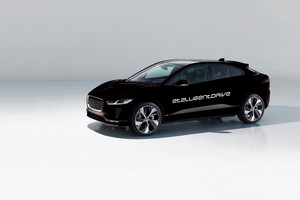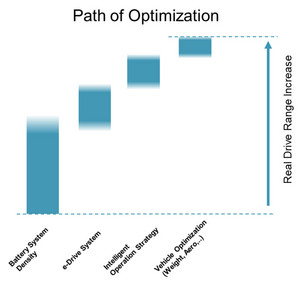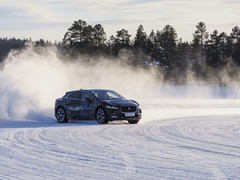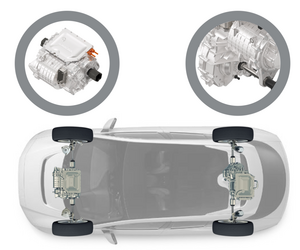As a technology leader, Magna contributes to sustainable mobility in the fields of e-mobility, autonomous driving, and future manufacturing processes. Regarding electromobility in particular: for the industry to be successful, electric vehicles must be more affordable and fully optimized by integrating all technical possibilities.
Therefore, automotive manufacturers need solutions that are affordable and reduce the vehicle’s CO2 emissions, while still offering the tangible benefits that consumers expect. In electric cars, these include greater range, shorter charging times, and a lower purchase price in a vehicle that is fun and safe to drive, as consumer acceptance is another key success factor for electromobility.
In 2018, Magna presented its modular and scalable drive system at its Winter Test event in Sweden; and at the 2019 event, the company unveiled its e2 demonstrator car with scalable hybrid functionality. The focus this year is on the e4 prototype, highlighting the next generation of electric vehicle powertrain systems. “The e4, a battery electric vehicle (BEV), demonstrates how cost, efficiency, and driving dynamics can be optimized without making any trade-offs”, says Harald Naunheimer, Vice President Future Products at Magna Powertrain.

Greater range, better dynamics
The e4 is equipped with an electric drive system on each axle (front and rear). Both e-drives are derived from the Magna scalable, modular system approach; they deliver a peak output of 180 kW each. The electric motor is a permanent magnet synchronous machine (PSM), which is characterized by low weight and a high average efficiency of around 90 percent in the WLTC (Worldwide Harmonized Light Vehicles Test Cycle), which helps increase the vehicle’s driving range. The e-drive unit’s highly integrated, compact design ideally supports the OEM’s installation space requirements.
The e-drive on the rear axle has a torque vectoring function that is implemented by an electromechanically actuated wet clutch, one per rear wheel – this solution requires no differential. Engineers chose this design to achieve the optimum combination of cost, weight, efficiency, and driving dynamics: the wheel-specific clutches make it possible to direct the available torque directly to one of the rear wheels, which optimizes driving stability and safety during dynamic cornering.
Further savings potential through consistent system integration
Magna continues to work on further optimization of e-drives with a second-generation system, optimizing decoupling strategies, winding technologies for the e-machines, and advanced electronic controls.
In addition, the vehicle needs to be optimized as a complete system to take full advantage of all that these e-drive solutions can provide. This includes a predictive operation strategy, which enables the vehicle to predict changes in terrain and traffic situations, leveraging the power of Car2X and artificial intelligence to derive an economical operating strategy. In addition, the battery represents a major opportunity. Battery system energy can be significantly increased by decreasing cobalt content, adding improved electrolytes, and further developing the battery management system. Other areas of optimization on a vehicle level include low-friction wheels, lightweight vehicle structure, reduced air resistance cooling systems, and a predictive operating strategy.

By combining these measures, it is possible to increase efficiency by more than 25 percent, with series applications starting in 2025. From the consumer’s perspective, this means that the range of an electric car designed for 470 km can be increased to 590 km, for example.
Achieving this requires a deep level of vehicle-wide system know-how, which Magna Powertrain leverages with the capabilities of the entire company, including electronics, driver assistance systems, software development, lightweight construction, aerodynamics development, and even overall vehicle development and production.
Affordable electrification through a scalable, modular drive system
The efficiency improvements mentioned above not only benefit battery electric vehicles, but also hybrid vehicles. For example, the rear axle drive of the e4 can also be used in a high-voltage hybrid vehicle, while offering the same efficiency and dynamics advantages. The modular drive concept offers a lot of freedom for electrification to be scaled to customer requirements.
Magna Powertrain uses a modular system of scalable building blocks, which enables a high share of common parts. This applies to both electric axle drives (e-drives) and transmissions for conventional and hybrid drives. For example, a common, state-of-the-art electric motor platform can be used for e-drives as well as hybrid dual-clutch transmissions. All these applications can also utilize innovations like the decoupling of drives to further increase efficiency.
“The scalability of building blocks and modular design allows tailor-made solutions to meet a wide range of customer requirements,” says Anton Mayer, Senior Vice President Engineering at Magna Powertrain. “This applies both to OEMs, who can reduce the consumption of their fleets, and to consumers, who benefit from lower costs, greater range, and more driving pleasure and safety.”




